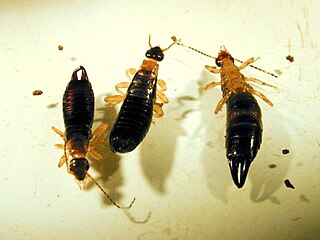Related Research Articles
The Aquificae phylum is a diverse collection of bacteria that live in harsh environmental settings. The name 'Aquificae' was given to this phylum based on an early genus identified within this group, Aquifex, which is able to produce water by oxidizing hydrogen. They have been found in springs, pools, and oceans. They are autotrophs, and are the primary carbon fixers in their environments. These bacteria are Gram-negative, non-spore-forming rods. They are true bacteria as opposed to the other inhabitants of extreme environments, the Archaea.
Mycobacterium doricum is a species of the phylum Actinobacteria, belonging to the genus Mycobacterium.
Mycobacterium frederiksbergense is a species of the phylum Actinobacteria, belonging to the genus Mycobacterium.
Paraburkholderia caledonica is a species of Proteobacteria.
The Chloroflexi or Chlorobacteria are a phylum of bacteria containing isolates with a diversity of phenotypes, including members that are aerobic thermophiles, which use oxygen and grow well in high temperatures; anoxygenic phototrophs, which use light for photosynthesis ; and anaerobic halorespirers, which uses halogenated organics as electron acceptors.

Auchenoglanis is a genus of relatively large, up to 70 cm (2.3 ft) SL, claroteid catfishes native to various freshwater habitats in Africa.

Arcanobacterium is a genus of bacteria. They are gram-positive, non–acid fast, nonmotile, facultatively anaerobic, and non–endospore forming. They are widely distributed in nature in the microbiota of animals and are mostly innocuous. Some can cause disease in humans and other animals. As with various species of a microbiota, they usually are not pathogenic but can occasionally opportunistically capitalize on atypical access to tissues or weakened host defenses.

Euborellia is a genus of earwigs in the subfamily Anisolabidinae. It was cited by Srivastava in Part 2 of Fauna of India. Euborellia are small, dark-colored earwigs. Species can be difficult to distinguish from one another. There are about 50 species.
Secotium is a genus of fungi in the family Agaricaceae. The members of this genus are closely related to ordinary Agaricus mushrooms, but do not open out in the usual way; this has given rise to the term "secotioid" for such mushrooms in general. They are thought to form an evolutionary link between agarics and gasteroid fungi. Secotium is a widespread genus, with species that are predominantly found in warm and arid regions.
Nitrospirae is a phylum of bacteria. It contains only one class, Nitrospira, which itself contains one order (Nitrospirales) and one family (Nitrospiraceae). It includes multiple genera, such as Nitrospira, the largest. The first member of this phylum, Nitrospira marina, was discovered in 1985. The second member, Nitrospira moscoviensis, was discovered in 1995.

The Haemoproteidae are a family of parasitic alveolates in the phylum Apicomplexa.

Opecoelidae is a family of trematodes. It is the largest digenean family with over 90 genera and nearly 900 species, almost solely found in marine and freshwater teleost fishes. It was considered by Bray et al. to belong in the superfamily Opecoeloidea Ozaki, 1925 or the Brachycladioidea Odhner, 1905.
The species of the genus Aquabacterium are motile, rod-shaped, Gram-negative, oxidase-positive, catalase-negative bacteria which were isolated from drinking water biofilms in Berlin. Identified species include Aquabacterium citratiphilum, Aquabacterium parvum, and Aquabacterium commune. Three bacterial strains isolated from biofilms of the Berlin drinking water system were characterized with respect to their morphological and physiological properties and their taxonomic position. Phenotypically, the bacteria investigated were motile, Gram-negative rods, oxidase-positive and catalase-negative, and contained polyalkanoates and polyphosphate as storage polymers. They displayed a microaerophilic growth behaviour and used oxygen and nitrate as electron acceptors, but not nitrite, chlorate, sulfate, or ferric iron. The substrates metabolized included a broad range of organic acids, but no carbohydrates at all. The three species can be distinguished from each other by their substrate use, ability to hydrolyse urea and casein, cellular protein patterns, and growth on nutrient-rich media, as well as their temperature, pH, and NaCl tolerances. Phylogenetic analysis, based on 16S rRNA gene sequence comparison, revealed that the isolates are affiliated to the beta 1-subclass of Proteobacteria. The isolates constitute three new species with internal levels of DNA relatedness ranging from 44.9 to 51.3%. It is proposed that a new genus, Aquabacterium gen. nov., should be created, including Aquabacterium citratiphilum sp. nov., Aquabacterium parvum sp. nov., and Aquabacterium commune sp. nov. The type species of the new genus is Aquabacterium commune.
Merogregarina is a genus of parasitic alveolate in the phylum Apicomplexa. Species in this genus infect marine invertebrates.
Virgisporangium ochraceum is a bacterium. It is a motile and spored species found in soil.
Virgisporangium aurantiacum is a bacterium. It is a motile and spored species found in soil.
Haliangium ochraceum is a species of moderately halophilic myxobacteria. It produces yellow fruiting bodies, comprising several sessile sporangioles in dense packs. Its type strain is SMP-2. Its genome has been sequenced.
Haliangium tepidum is a species of moderately halophilic myxobacteria. It produces yellow fruiting bodies, comprising several sessile sporangioles in dense packs. Its type strain is SMP-10.
Stenorhynchosaurus is an extinct genus of pliosaurid plesiosaurs which lived in South America during the Early Cretaceous. The type species and only known is Stenorhynchosaurus munozi.
Halofilum is a Gram-negative and facultative anaerobic genus of bacteria from the family of Ectothiorhodospiraceae with one known species. Halofilum ochraceum has been isolated from a marine solar saltern from the coast of Weihai in China.
References
- ↑ Tamura T; Hayakawa M; Hatano K (2001). "A new genus of the order Actinomycetales, Virgosporangium gen. nov., with descriptions of Virgosporangium ochraceum sp. nov. and Virgosporangium aurantiacum sp. nov". International Journal of Systematic and Evolutionary Microbiology. 51: 1809–1816. doi: 10.1099/00207713-51-5-1809 . PMID 11594613.